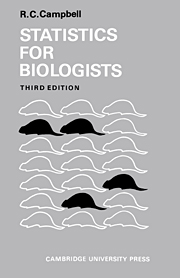Book contents
- Frontmatter
- Contents
- PREFACE
- PREFACE TO SECOND EDITION
- PREFACE TO THIRD EDITION
- 1 WHAT IS STATISTICS ABOUT?
- 2 PRESENTING THE INFORMATION CONTAINED IN ONE SAMPLE
- 3 COMPARING SEVERAL SAMPLES
- 4 ASSOCIATION
- 5 CHOOSING BETWEEN ACTIONS
- 6 THE NORMAL DISTRIBUTION
- 7 THE NORMAL VARIABLE IN EXPERIMENTS AND SURVEYS
- 8 ASSOCIATED NORMAL VARIABLES
- 9 SOME NON-NORMAL DISTRIBUTIONS
- FURTHER READING
- REFERENCES
- APPENDIX: TABLES AND FIGURES FOR STATISTICAL TESTS AND EXERCISES
- INDEX
7 - THE NORMAL VARIABLE IN EXPERIMENTS AND SURVEYS
Published online by Cambridge University Press: 05 June 2012
- Frontmatter
- Contents
- PREFACE
- PREFACE TO SECOND EDITION
- PREFACE TO THIRD EDITION
- 1 WHAT IS STATISTICS ABOUT?
- 2 PRESENTING THE INFORMATION CONTAINED IN ONE SAMPLE
- 3 COMPARING SEVERAL SAMPLES
- 4 ASSOCIATION
- 5 CHOOSING BETWEEN ACTIONS
- 6 THE NORMAL DISTRIBUTION
- 7 THE NORMAL VARIABLE IN EXPERIMENTS AND SURVEYS
- 8 ASSOCIATED NORMAL VARIABLES
- 9 SOME NON-NORMAL DISTRIBUTIONS
- FURTHER READING
- REFERENCES
- APPENDIX: TABLES AND FIGURES FOR STATISTICAL TESTS AND EXERCISES
- INDEX
Summary
The analysis of variance
In the previous chapter we discussed methods that can be used with the normal variable when we are interested in one or two populations; the purpose of the present chapter is to extend these techniques to cases with more than two populations. We shall consider, as usual, both single-factor and two-factor classifications; we shall therefore give, amongst other things, the normal analogues of the Kruskal–Wallis (3.3) and Friedmann (3.4.2) procedures.
In both these cases we shall consider examples of the very general technique known as the analysis of variance (anovar); it is convenient to explain first the principle of this technique. In spite of its name, the object of the anovar is to provide statistics which are useful in comparing population means; the method can be used only with normal variables, and we shall find indeed that certain further restrictions are also required. The general procedure, applying to all anovars, is to determine how much of the variation in our observations is due to population differences and how much to random variability; by comparing the contributions of these two kinds of variation we can determine the importance of the population differences.
The most convenient measure of variation with a normal variable is, as we already know, a sum of squares and all anovars begin therefore by the computation of a sum of squares to measure the overall variation of all the samples taken together; this is known as the total sum of squares.
- Type
- Chapter
- Information
- Statistics for Biologists , pp. 199 - 315Publisher: Cambridge University PressPrint publication year: 1989
- 2
- Cited by



